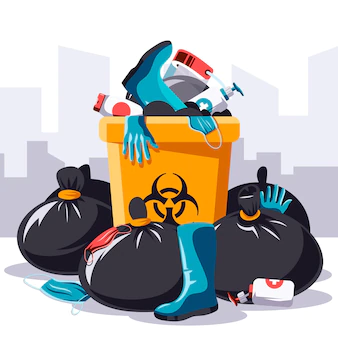Medical Waste Management
Medical Waste Disposal & Management
Medical waste is broadly classified as any item that comes into contact with body fluids. Specifically, it is any solid waste that is generated in the diagnosis, treatment or immunization of humans. This type of waste was once collected in special bags and plastic boxes in clinical settings and then disposed of like normal trash. However, this process was quickly found to spread diseases and viruses and potentially cause outbreaks.
Today, the red biohazardous containers and bags seen throughout hospitals and doctors’ offices are used to safely remove sharps, needles, and IV catheters that contain any human blood or bodily fluid. Medical waste also includes paper towels, wipes, gloves, syringes without needles, bandages or dressings with small amounts of dry blood or fluid, and any other material from medical care. Syringes with needles or sharp objects that can pierce through a plastic bag require a special storage container for additional protection

Biohazard Containers Can Safely Used
- Sharps
- Needles
- IV Catheters
Medical Waste
- Paper towels or wipes contaminates
- Gloves used in procedures
- Syringes without needles
- Syringes with needles or sharp objects
- Bandages or dressings with small amounts of dry blood or fluid
- Any other material from medical care
What is Medical Waste?
Definition, Types, Examples & More
Medical waste disposal is one of the biggest day-to-day challenges faced by healthcare providers. It’s often complicated by other concerns like HIPAA, epidemiology, potential civil litigation, and state and local regulation. Because at MedPro Waste Disposal we aim to help providers become better providers, we’re taking a look at the key concepts around medical waste.
Definition of Medical Waste
Medical waste is any kind of waste that contains infectious material (or material that’s potentially infectious). This definition includes waste generated by healthcare facilities like physician’s offices, hospitals, dental practices, laboratories, medical research facilities, and veterinary clinics. This includes:
- Anything that is soaked in blood (gloves, gauze, gowns, etc.)
- Human or animal tissues created during procedures
- Cultures of infectious diseases/agents
- Any waste produced in patient’s rooms with communicable diseases
- Discarded vaccines
Medical waste can contain bodily fluids like blood or other contaminants. The 1988 Medical Waste Tracking Act defined it as waste generated during medical research, testing, diagnosis, immunization, or treatment of either human beings or animals. Some examples are culture dishes, glassware, bandages, gloves, discarded sharps like needles or scalpels, swabs, and tissue.
Different Medical Waste
Medical waste goes by several names that all have the same basic definition. All of the terms below refer to waste created during the healthcare process that’s either contaminated or potentially contaminated by infectious material.
- Medical Waste
- Biomedical Waste
- Clinical Waste
- Biohazardous Waste
- Regulated Medical Waste (RMW)
- Infectious Medical Waste
- Healthcare waste
The terms are used interchangeably, but there’s a distinction between general healthcare waste and hazardous medical waste. The WHO categorizes sharps, human tissue, fluids, and contaminated supplies as “biohazardous,” and non-contaminated equipment and animal tissue as “general medical waste.”
In fact, office paper, sweeping waste, and kitchen waste from healthcare facilities is still technically medical waste, though it’s not regulated and not hazardous in nature.
